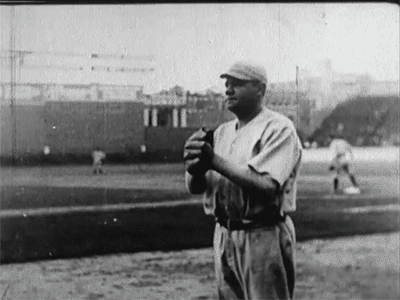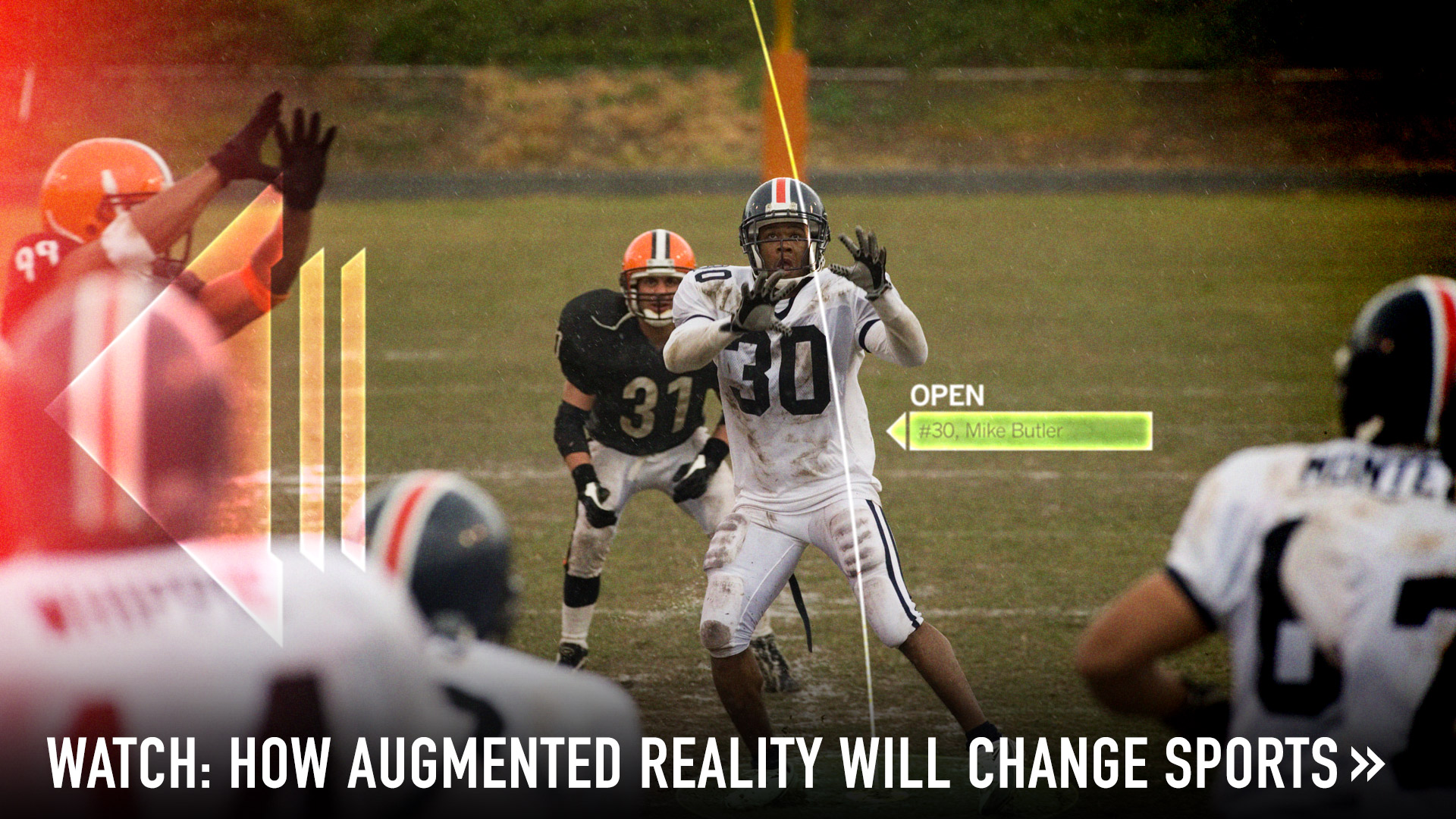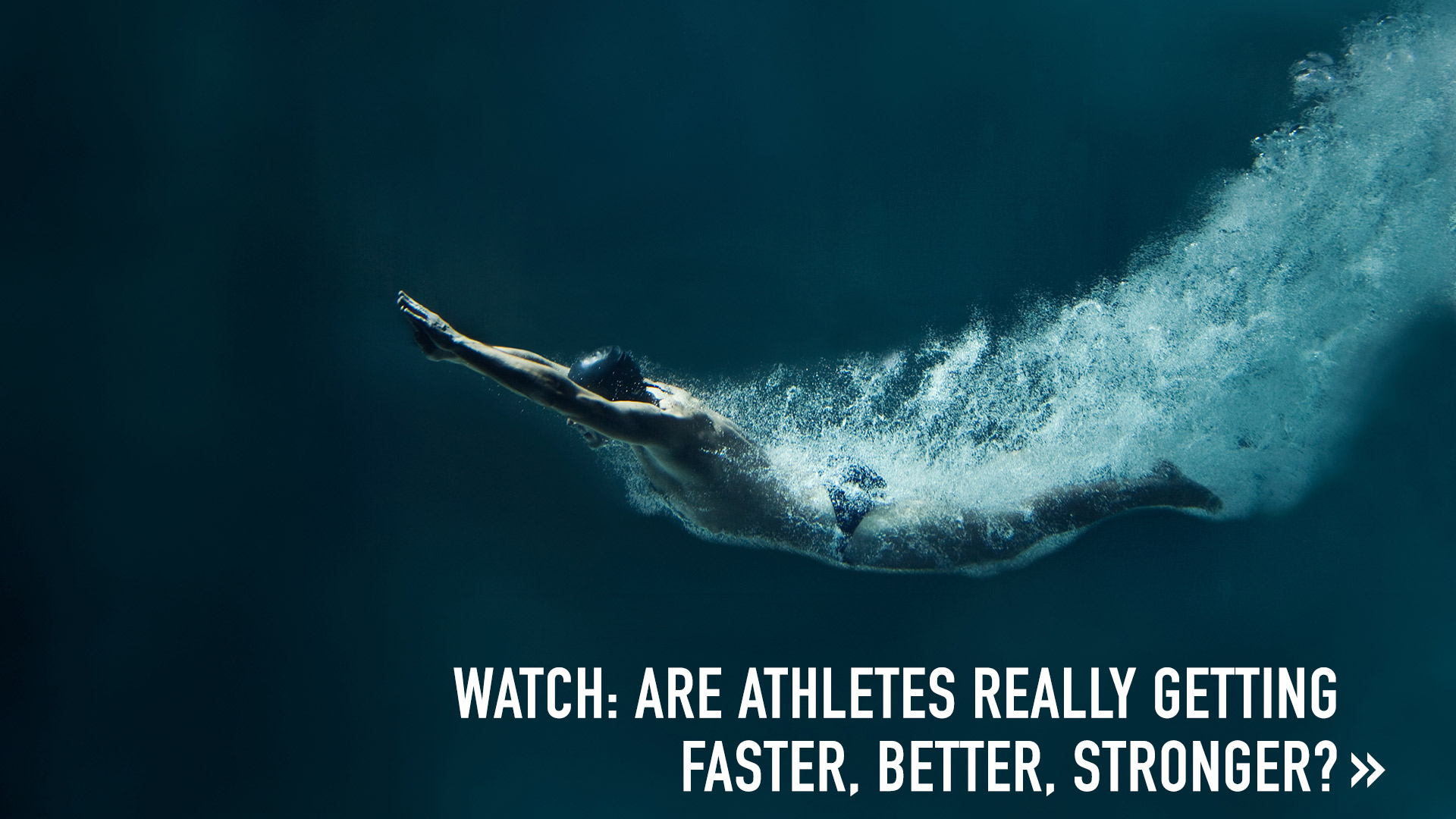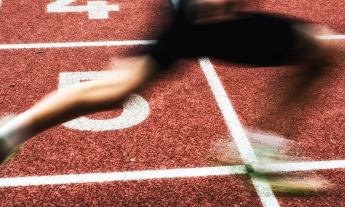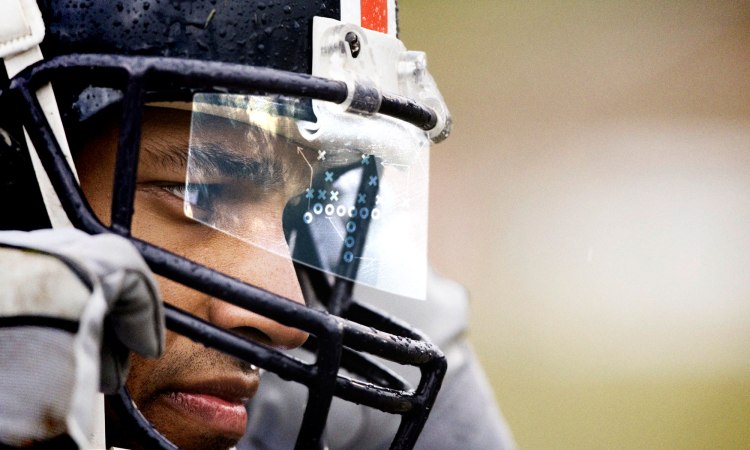
If you’ve ever seen grainy old sports footage—for example, a boxing match from the late 1800s, a Princeton/Yale game from 1903, or Babe Ruth’s famous home run from 1932—you probably noticed how different the game looks compared to its modern counterpart. The equipment looks clunky, the uniforms impossibly baggy. Even the bodies of the players look weirdly out of shape. Why is that?
Like any human endeavor, sports evolve over time. Science and technology fuel these changes, providing ever-better gear made with superior materials, better information about nutrition and training, and improvements in data generation and analysis that help push the limits of athletic capability.
Sports science journalist David Epstein (TED Talk: Are athletes really getting faster, better, stronger?) thinks a lot about how athletics change rapidly over time, while NFL punter Chris Kluwe (TED Talk: How augmented reality will change sports … and build empathy) ponders the impact AR, particularly Google Glass, could have on major sports. We invited them to have a conversation with Cynthia Bir, lead scientist at ESPN’s Sport Science, who took a look at how basketball players use physics to make shots at TEDYouth late last year.
Below, an edited transcript of that conversation. Read on to hear how each of these thinkers parses the fine line of fairness when it comes to new science and technology in sports, and what each thinks competitions will look like 10 years from now.
How did each of you became interested in looking at the intersection of sports and science?
Cynthia Bir: I’m a biomedical engineer and my focus of research is in injury biomechanics. It’s an obvious area where we need to study the injuries that might be occurring, and the ways that we can prevent or predict them. A big topic right now is traumatic brain injuries in sports, and so being able to really understand what happens in various sports—not just football, but in all sports, in terms of what causes traumatic brain injuries—is key. I have some personal interest, because I have kids and they participate in a variety of sports. And so it’s one of those things that if you feel like you’re actually making a difference with your research, it adds some validity to it.
David Epstein: For me, I was a national-level middle-distance runner and went on to become a science grad student. I transitioned into sports science writing after one of my training partners dropped dead after a race. I got really curious about how that could happen to someone who otherwise seemed to be a picture of health. So ultimately, I had his parents sign a waiver to allow me to gather up his medical records, and learn that he suffered from this particular gene mutation that’s most commonly the cause of sudden death in athletes.
“Inside my own training group, five guys were becoming more different athletically rather than more the same, even while we were doing the same training.” David Epstein
It was that experience, as well as another experience in sports in high school that led to me writing about genetics in sports. I grew up with a lot of Jamaican guys, and we had this great high school track team. At the age of 16, I looked up Jamaica in an atlas and realized there are two-and-a-half million from that island—I started to wonder what was going on there. As I moved up to running longer distances in college, I was running against Kenyan guys, getting to know them, and realizing they were all from the same town, basically — from this big minority tribe in Kenya. It was, again, “What’s going on?” Inside my own training group, where I was living and eating and training with five guys, we were becoming more different in many ways athletically rather than more the same, even while we were doing the same training. I started to want to look into some of those questions. That’s how I transitioned out of science grad school and into sports science writing.
Chris Kluwe: I’ve been in the NFL for eight-and-a-half years, and obviously played high school and college athletics before that. For me, I’ve always been interested in the idea of science and technology emerging—science and technology that we don’t really pay attention to at the time, but when we look back, we say, “Oh, hey, that was a pretty cool idea.” Things like cell phones or the Internet that transformed the way we lived our lives. As an athlete, what I’ve seen with Google Glass and with augmented reality is, I think, not quite a transcendent moment, but one of those moments where things will shift. Sports are a vehicle for many, many people—you have a very wide audience, and so when you get these emerging technologies in sports, then you see them adopted very rapidly. That’s what I was interested in. The idea that now we can actually record from a first-person perspective what it is like to be a world-class, professional athlete on the field, and then experience that through either seeing it on TV or other media.
With Google Glass, how do you see that technology changing the landscape of football—and other sports—in the future?
Chris Kluwe: I think it will initially shift the viewing perspective. People will now have another way to watch the game—from the athlete’s perspective. It’ll no longer be just the overhead cameras and the sweeping Skycam— you’ll actually be able to see what your favorite player did on the play from his or her perspective. That’s something that we’ve never really had up to this point.
From there, it leads to people becoming more comfortable with the idea of things like augmented reality and virtual reality, which leads into that being adopted more and more into everyday life. In the sporting world, that means augmented reality being adopted into the actual sports themselves. For football, you could have a projector that displays your next series of plays on your helmet as you’re running back to the huddle. Or something that highlights the receiver, or warns you if a guy is coming off your blind spot, for instance tackling against quarterback.
You see this a lot in the military—on displays in fighter jets, and I think they’re working on actual ground-based troop systems as well—there’s this filter of information between you and the world, an additional layer of information that you can use to enhance your own senses. I think we’re at that point right now where not a lot of people realize that, just like not a lot of people realized that the Internet was going to be something that spread and covered the entire world, or that cell phones would be as ubiquitous. No one even thinks of not having a cell phone, but there was a point when cell phones were big briefcase, clunky things that only executives on Wall Street had.
Cynthia and David, what’s an advance in science or technology that you think will change the landscape of sports in the coming years?
Cynthia Bir: I would have to say some of the motion-capture techniques that are out there. They no longer require markers or instrumentation to be placed on the athlete—you can just use the camera. Some people are using Kinect systems, and some people are using a little more high-tech systems. We’re able to tell exactly how the athlete is moving in real time. When you have an athlete performing at a certain level, you’re trying to explain, “Okay, this is what you need to do,” or “this is the motion.” Having a system where you can get real-time data, provide it back to that person and say, “You’re pushing off with your right leg more than your left leg,” or “you need to adapt this,” or “you need to adapt that”—it’s going to really enhance a lot of athletes’ ability to perform. We have a lot of biometric type feedback stuff available to us now as well in terms of just being able to monitor heart rate, respiratory rate, and things of that nature during the actual event. So I think that instant feedback that we’re now getting with our sensors will be critical.
David Epstein: I’m going to give two. One is individualized training. I’m interested what’s happened with sports science in the decade since the sequencing of the human genome. Although there’s a lot left to learn, just as we’ve learned the differences in my gene that’s involved in acetaminophen metabolism from yours—I might need three Tylenols while you need one to get the same effect, or maybe no amount works for me—we’re finding genes that make some people more trainable to particular training programs than others. Not only genes, but actually direct physiology, whether it’s properties of muscle fibers or things like that, that can help you figure out what the best training plan is for an individual. Just as there’s no perfect medication regimen for any individual, because we’re so biologically unique, there’s no one single perfect training plan that works for everybody.
Some countries that are starting to put this into effect. Denmark and the Netherlands are doing things like muscle biopsies, and moving athletes around sports based on that. Or if the athletes are plateauing in training, you can tailor training to their specific physiology to get better effects. That’s really neat, and can be done with fairly easy interventions. I think we’re going to continue moving in that direction, toward individualized training to get the optimal training environment for every individual.
The other thing I wanted to mention: occlusion testing, where you block certain parts of perceptual information digitally or virtually. Either in the field with special types of glasses and things like that, or in videos by deleting parts of players’ bodies or time segments of the action, to figure out what information athletes actually need to predict what’s coming in the future faster than they could do consciously. You can use that to understand what they should be exposed to the most, what kind of practice scenarios are not wasting time, essentially. It turns out that pitching machines are completely wasting time, because they don’t teach you the perceptual cues of a pitcher’s body that let you anticipate a pitch. This is why softball pitchers can always strike out major-league baseball hitters. I think this occlusion testing is helping us focus our training time only to athletes’ better perceptual skills. And it might even be connected to some of the virtual reality stuff that Chris is talking about. That would be a great way to use it on the field.
Chris, hearing Cynthia and David talk about these examples, are these things that you’ve used in training? Have you used motion-capture video, or individualized training, or occlusion testing, or anything like that?
Chris Kluwe: Yes, I’ve actually seen occlusion testing used on the practice field. Nike had a pair of polarized lens glasses that would flash to block incoming light, essentially blinding you every half a second or every second, whatever you wanted to set it at. It is mainly for the receivers training to focus on the balls coming in and predict where the ball was going to be, even if they couldn’t watch it the entire way in. When you’re running on the field, when you’re trying to fight the defensive back, then you’re not going to be able to just stare the ball all the way into your hands. You have to predict where it’s going to end up, and then know when to close your hands to catch it. I’ve seen stuff like that.
When it comes to using technology or science to improve sport performance, what’s the line between fair and unfair? I was thinking of the example of doping earlier. That’s a medical technology that is totally taboo in sports. So what do you think is different between doping or something like Google Glass, or an improved swimsuit, or lighter running shoes, or any of these technologies that you just mentioned?
Chris Kluwe: One of the main concerns with doping right now is the fact that it isn’t regulated and people are worried that it is cheating, in a sense. It’s allowing you to move past what your body would normally be capable of. And that’s determined by the rules of the game itself. That’s more of a societal question: what do you determine as the limits for your game? Are doping or mechanical assistance allowed? That’s not really so much a sports question as it is a “what do you want from your sports?” question.
“With augmented reality in football, a team that has algorithms that allow them to predict what the other team is going to do a tenth of a second faster will have a competitive advantage.” Chris kluwe
But in terms of stuff like augmented reality, like sports science, I think that’s a natural progression of any sport. People want to know more about sports, they want to understand why things work. And you see that in baseball, with the rise of sabermetrics—the idea that there are stats that we can track and collate that may actually make a difference, so we need to be tracking and collating. And if we don’t, we’re at a competitive disadvantage. With augmented reality in football, a team that has algorithms that allow them to predict what the other team is going to do a tenth of a second faster will have a competitive advantage. And so now, your scouting department is important but your IT department is just as important, because they’re in charge of making sense of that data. I think it is a natural progression of sports themselves.
David Epstein: I think Chris said something beautifully that we should all think about, which is that you have to ask: what do you want from your sport? With respect to doping, sports are—we would say—the ultimate human contrivances. It’s just like taking agreed-upon rules for something that’s otherwise not meaningful, and adding meaning. And so I think when it comes to doping, there’s a lot of debate about whether we should look the other way, but I think it’s totally fair to argue about changing the rules. If you feel like the value in sports emanates from agreed-upon rules, then I think if you’re into those rules, it’s important.
There are certain things that are on the banned substance [list] that won’t always be. Things that should be explored for helping players recover more quickly, and I think it’s a shame that they’re not. That said, I wouldn’t say it’s a non-issue if a player decides to do that anyway, because the rules in sports are important. As far as the technology goes, I think if we only wanted to see strictly what the normal human body was capable of, we’d make people with 40-hour-a-week jobs play against one another. We’re already to the point beyond the athletes themselves. The support group and the technology companies are part of the expression of human creativity that is sports.
Cynthia Bir: The only thing that I would add: is it just some sort of mechanical advantage? Certain people have better access to equipment and resources and things of that nature, and that’s just what happens as you progress through the echelon of sports. But if something comes out that for some reason gives a mechanical advantage that has nothing to do with athleticism, then I think that needs to be looked at.
How do these scientific and technological improvements that we’re talking about trickle down from the pros to the average player? One of those people who, like David said, works 40 hours a week and maybe plays on the company softball team, or a kid in a soccer club at school. At what point do these technologies reach the rest of us?
Cynthia Bir: I think that it depends on the technology. There is an advantage when dollars are put into the technologies at the higher levels—ultimately it will trickle down to the Little Leagues of the world. There’s a lot of research and development that’s going on across the board that will trickle down and help out even the weekend warrior at some point in time. The developmental cost is already there, so it’s then mass-produced. Some things will trickle down faster than others, but ultimately, I think, all will have advantages that the general populace will see.
David Epstein: I think Cynthia’s totally right. It depends on the technology. With respect to some of the technology that pro athletes use for health, sometimes I’ve been a little disappointed at the lack of trickle-down. But I think maybe that’s just because I’m expecting it to happen too quickly.
What are some examples of that?
David Epstein: Some of the things with brain testing. Not even technology, but just the kind of healthcare that you have, that kind of sideline assessment. Some of the neuro-cognitive testing that’s done for concussion or brain trauma has pretty much been shown to be too easy to actually assess a lot of concussions. So you’re just not making your test difficult enough, and that seems to me not to have been realized at lower levels of football. This part of the competitive population is the largest, has the most vulnerable brains, and is at the most risk. And it sometimes has the least care.
But I think in terms of things that improve training and the kind of technology that Chris was talking about, absolutely. There is no better advertising than a high-performance, elite, world-class athlete using something where a zillion people can see it. There’s the capacity for trickle-down much more rapidly than in many other scenarios.
Chris, Google Glass is still expensive, but have you heard from any recreational players that have tried that out in their own sport?
Chris Kluwe: I’ve seen videos from people who’ve worn it, or worn GoPros or something similar, trying to get that perspective in. Obviously a lot of it has to do with the popularity of your sport, and what the ease of access is to get that technology. Because when you see that actually it’s using a product, that product is obtainable in terms of the average working person’s income, it’s going to trickle down much, much faster than something like, say, a hyperbaric oxygen chamber. For the average person, that’s not something they can just go out and pick up at a sporting goods store.
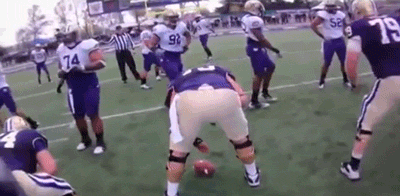
Professional sports are more the prototyping stage where companies put this technology out there so that they can gauge the interest in it, and see what kind of impact it has on the game. If people are interested in it, economies of scale can be put into place to make it attainable by enough people. That’s when you start seeing that trickle-down effect. That’s when you start seeing people getting better Nike and UnderArmour-type compression girdles and sports gear.
In terms of the concussion testing, that’s something that I don’t think you’re going to see trickling down until the sport itself makes even more of an emphasis on saying, “Hey, this is something that we have to deal with.” Because right now, it’s very much a public perception thing where the NFL wants people to say, “Yeah, they’re trying to do something.” But the fact remains, the NFL wants players out on the field playing the game because that’s how they make their money. That’s what people are there to see. Until that changes, then you’re not going to get that trickle-down to the lower levels of sports, because the players will always want to go back into the game, because they’re out there to play. It’s up to the people around them to be able to say, “No, you can’t go back into that game because you haven’t passed the appropriate test. You can harm yourself further by going back in. You need to be saved from yourself.”
Cynthia Bir: I think what we’re dealing with right now, it’s not a lack of education. There are a lot of resources out there. The CDC has resources available for Heads-Up: Concussion and there are SLICE programs out there, which is a concussion recognition program that goes into high schools and junior highs and talks about how to detect concussions in sports. There is some trickle-down that’s occurring in that area. There is a lot of information and technologies available out there for both high school and Pop Warner leagues. It’s just a matter of getting the word out to the coaches, to the trainers, to the parents that that’s available.
I agree that some of the sideline cognitive testing probably hasn’t been, I guess you could say as diligent as we would like it to have been in the past, but I think there’s a lot of new technologies and a lot of new testing that’s coming out that will be implemented in the next months. Not years, but months. The problem’s been recognized, and we’re starting to move forward.
David Epstein: There definitely is way more stuff out there than there was and I didn’t mean to imply there wasn’t. One thing I’ve seen are high schools that have athletic trainers—certified athletic trainers. And a lot of high schools, unfortunately, don’t.
Cynthia Bir: That is true.
David Epstein: And to Chris’ point, he made me think of one technology I’ve seen—the so-called AlterG treadmill. You slip into a pressurized kind of bubble for your lower body, and you can adjust how much of your body weight this pressurized bubble carries. I first heard of that maybe a couple of years ago, only with really elite athletes, but I’m just started seeing it pop up in physical therapy clinics and also in a few gyms here and there. I think the price is starting to come down. If that price keeps coming down, that will be something that’s sort of more standard in gyms, because it’s really, really useful, especially for rehab.
“you have to wonder, ‘Okay, what’s our limit?’ Are we going to get to that point where we can’t beat a time, or we can’t improve something?” cynthia bir
My next question is for Cynthia. I saw a talk that you gave online about the limit of human sport performance, and I was wondering if you could talk about some of the major limits both for the human body and in the ways science and technology can maximize our capability for sport.
Cynthia Bir: Every sport is so different, right? And there’s going to be different limits on different sports. But I think some of the points that we talked about earlier in terms of the technology—like identifying different genes and different ways that we can enhance and recover—will ultimately lead to athletes who are breaking records. That was my point in the talk: that if you look at the Olympics, especially the Summer Olympics as I didn’t really track it for the winter ones, we were still breaking world records. And you have to wonder, “Okay, what’s our limit?” Are we going to get to that point where we can’t beat a time, or we can’t improve something? There obviously are going to be limits. Biomechanically, we’re just built in a certain way and you’re only going to be able to have somebody run a 40-yard dash so fast. Have we reached them? No, I don’t think so. I think we’ll still see some improvements. We’ll see world records broken in every sport as we learn about the body and we study it and research it more.
Chris Kluwe: I would just want to hit you back on that previous point. Basically the entire idea of sports is trying to discover what those limits are. Because every generation, we feel like we’ve reached that pinnacle where we’ve run the fastest 40 time we’re going to run, or we’ve gone the fastest through the downhill we’re ever going to go, or this technology is perfect, or technology can’t get any better. But then we always go past it.
I think the key thing for sports science is understanding that every generation thinks it’s going to find those limits, but so far we haven’t. So we have to continuously keep looking for them, because I don’t even know if we’ll know when we find them. It will take quite a while to accumulate enough data to realize that.
You look at the strides that have been made over the past even 50 years in terms of shoe technology. You look at what cleats are these days compared to what cleats people wore back in the sixties and seventies. It’s night and day, and it drastically changes how you play your game. And that’s just something you wear on your feet. So I think it’s very much that sports science is that constant pushing, that constant testing of those limits—of trying to find where that absolute maximum limit is—that’s something we’re probably not ever going to find. In order to find that limit, we don’t just need know how the human body works in terms of physio-mechanical structure, we need to know how the human mind works in terms of: How do you make yourself push that extra ounce of energy? How do you make yourself keep going when every cell in your body is telling you that you can’t—that you’re done. But your brain finds a way. You can’t just look at it as a pure physiological performance, it has to be everything that makes up your body and your mind.
Cynthia Bir: That’s a good point. I think, anecdotally, that sports psychology is becoming more popular. You hear about it more, you hear about people who actually go and talk to sports psychologists in terms of, “I have a mental block, how do I get past this?” Or, “how do I focus my mind and do this?”
I think you’re right that it’s the physiological part of the body, and then it’s the technology too. That’s a very good point—that we don’t know what shoes are going to look like 10 years from now, because we sure didn’t know what they were going to look like 10 years ago in terms of what they are now. Materials have improved—they’re lighter, there are different types of rubbers for the insoles. I think you’re right—several components come together to improve performance.
David Epstein: I agree with all of that. I also want play devil’s advocate a little bit. In terms of the brain, I just visited a lab in South Africa where they are doing various things and then measuring the electrical impulse between the brain and the muscle fibers to see how many muscle fibers are recruited in different tasks. To see how that can be manipulated and fool somebody about their work out. They have all kinds of different interventions to see how they can trick the brain into allowing you to use more of the physical resources. Because your brain’s not going to stop you from dying, apparently. It doesn’t mind if you run a little faster. There was a really cool study I saw there where they would fool people about how hot it was in the room they were in, and it basically negated the effect of the slowdown that the heat had on them. They would reset the thermometers, and all kinds of stuff like that.
Cynthia Bir: That’s most scary.
David Epstein: Pretty cool, yeah.
Chris Kluwe: Incredible.
DE: Yeah, very. So if anyone Googles “central governor theory,” that’s what they’re working on. This is why amphetamines, for example, are an incredible endurance aid, and yet they only act on the central nervous system—they don’t act in the muscles. It turns out this lab did a placebo-controlled trial and one with amphetamines. Normally your brain stops recruiting as much muscle when your core temperature hits 104 and you have to slow down. The amphetamines allow you to keep going without knowing that. So it removes your central inhibition from overheating. It’s a great endurance aid, but it also means it makes you prone to heatstroke if you go too hard. But they don’t act in the muscle.
To play devil’s advocate a little bit more—women’s records in track and field have been completely stuck in the eighties. Women appear to be getting slower, and I think that’s largely because that was an era of mega-doping that’s a little harder to do now. So I’ll be curious to see if women’s track and field athletes ever again eventually climb back toward those records, because so far that hasn’t happened. Meanwhile, men’s records in track and field are not all stuck. I’m really curious to see which records stagnate, and which won’t. I think the endurance records—the marathon and ultra-marathon—are the ones that we’re really going to see a lot of progress in, in the near future.
Chris Kluwe: The interesting thing to see about records is that, generally, record-breaking progression is very logarithmic, in that you have kind of those big chunks at first, and then it really starts to slow down as you get closer and closer to what that limit is. Until you have that next breakthrough in sports technology—in science, in bio-physiology, whatever it happens to be. Until you hit that breakthrough, then yeah, you’re going to plateau. Then it becomes—what’s that next breakthrough?
One last question for all of you. What are each of your predictions on the craziest, coolest or most shocking thing we’ll see happening in sports 10 years from now?
Chris Kluwe: For me, personally, probably the most outlandish thing I can think of—I’d say there’s maybe 25% chance of it actually happening—is the idea of actually replacing human bodies with artificial bodies in terms of sports. Where people will either remotely access or log in, in a fashion, to an artificial body. If it’s a robot body, or something constructed with synthetic polymers, something like that, in order to reduce the risk of injury to actual human beings. Because I think you’re starting to see that more and more—especially in football players, but in other sports as well—that people are starting to understand that there is a toll that sports takes on a human body. As a society, we have to ask ourselves a question—is this worth it to us in order to be entertained? Is it worth it to us to have people drop dead after a race? Or to be crippled for life in order that we can watch and be entertained? As technology progresses to a point where it is possible to duplicate the human experience, but also take it out of the equation so people aren’t actively being harmed, I can see that definitely taking off and supplanting actual flesh-and-blood sports at some point.
More realistically, I think what will happen is that we’ll start to see much more augmented reality and virtual reality interfaces in sports. I think that that’s a natural progression—as people become more used to that type of technology in their everyday lives, then it becomes natural for them to see it in their entertainment as well.
David Epstein: I think some of it depends on who enters the competitive population. I think there’s a good chance that we’ll see a double amputee, because of advances in prostheses, be capable of winning a gold medal in the able-bodied Olympics. Actually, I heard the U.S. right now has the largest Paralympic athlete pool ever, because it’s had soldiers coming home with injuries for a while now.
One thing I think we’ll see for sure within the next 10 years is more widespread use of hyperoxic training, which is people who are training with masks on to give them more than atmospheric oxygen, because it turns out that the body will work out much harder than you can normally. The oxygen mask that football players use between plays, when those have been tested versus placebo masks, they actually don’t work, because when you’re resting, there’s plenty of oxygen in the air around you. The problem is you can’t get it where it needs to go quickly enough in your body. But when you’re actually working out as hard as you can, and you’re an elite athlete, you can move your blood so fast that it doesn’t catch as much oxygen as it could. So if you’re working out with a mask on, that increases that oxygen pressure around you, and you can actually work out way harder than you would be able to normally. I think you’ll also see places like some of the countries that have sort of centralized sports science institutes build facilities that are hyperoxic conditions to allow athletes to train in them often.
Cynthia Bir: I would say that we’ll see the move to some of the real-time technology and feedback used during an actual sporting event. Because we do a lot during training and we do a lot during practices, and we get numbers and feedback. But to actually do it during a game is quite different. We’ve done a lot of research. Let’s say in boxing, when you have people sparring versus during an actual bout, you see quite a bit of differences in terms of punch forces and what is sustained during the fight. So I think having some more of the real-time monitoring of all sports—football, baseball, everything—will provide that instant feedback. That’s kind of what we’re all about now in the world, and in the U.S. specifically, is getting that instant feedback and having those numbers and those metrics right away so you can make decisions. I think we’ll start to see more and more teams, coaches and athletic trainers using that instant feedback, whether it be to detect an injury or to say, “Okay, this is what’s happening on the field, and this is how you need to adapt to it.”
Check out David Epstein’s book, The Sports Gene and watch his TED Talk.
Find out more about Chris Kluwe’s book, Beautifully Unique Sparkleponies and watch his TED Talk.
Watch Cynthia Bir’s ESPN Series, Sport Science.
Babe Ruth gif via Giphy. Swimmer photo courtesy of David Epstein. All other images courtesy of Chris Kluwe.

